Promotions don’t happen in the spotlight. They’re usually decided in quiet rooms by people who remember your last few wins, trust your judgment, and believe you’re already thinking one level up.
That’s why “I work hard” can still hit a ceiling. Good output without visibility, distant relationships with management, and protected thinking time can make it look like you’re great in your current position, but maybe you’re not ready for the next one.
The Promotion Equation
Promotion = Results × Visibility × Trust × Timing
Think of this as a multiplication problem: if any term is close to zero, your promotion case stalls. Your job is to raise each lever enough that decision-makers see “ready now,” not “maybe later.”
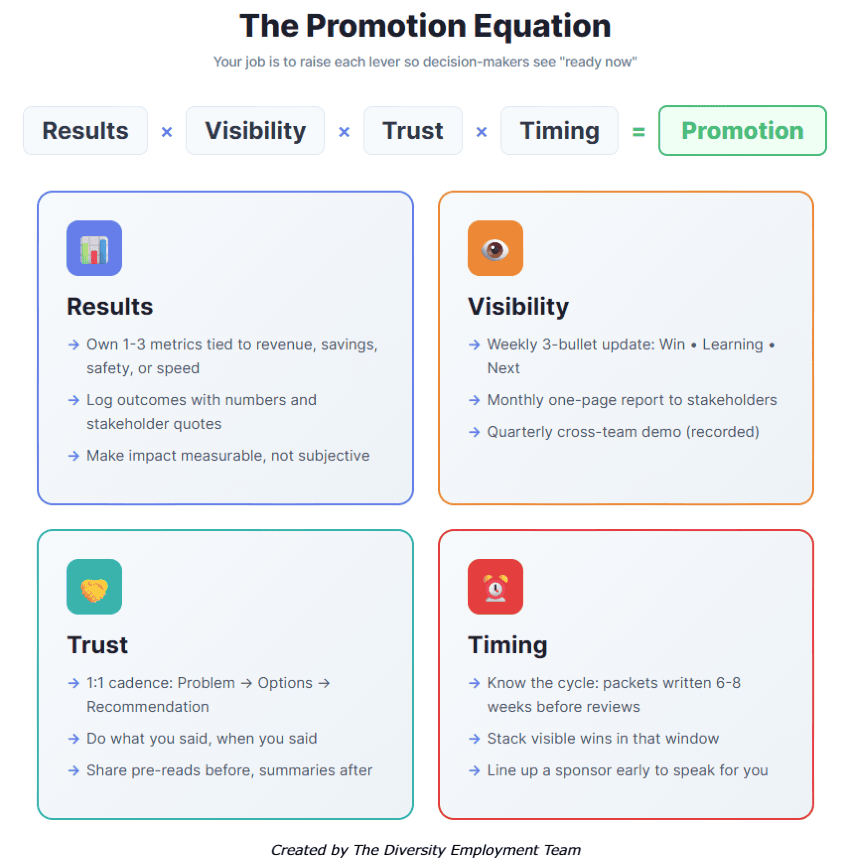
Results Driven Mindset
Promotions start with an impact you can actually measure. Make it habit to link your work to revenue, savings, safety, or speed, and keep receipts as you go.
- Own 1–3 metrics tied to revenue, savings, safety, or speed.
- Log outcomes with links, numbers, and a stakeholder quote.
Visibility Matters as Much as Your Work
Work can’t speak for itself, people do. Make it effortless for your manager and stakeholders to find and see recent, relevant wins.
- Weekly manager update (3 bullets): Win • Learning • Next.
- Monthly report to main stakeholders (one page, links only).
- Present one cross-team demonstration each quarter (record it).
Trust: Can They Bet on You?
Leaders promote people who reduce uncertainty. Show you can identify problems, propose a fix, and follow through on it.
- 1:1 cadence: bring problems → options → recommendation.
- Do what you said, when you said; note risks early.
- Share pre-reads before meetings; summarize decisions after.
Timing Can Stall Your Promotion
In most cases promotion decisions happen weeks before their announcement. Present your saved wins in that time frame and have your receipts ready. Having a sponsor ready to vouch doesn’t hurt either, but we’ll get into that a little later.
- Know the cycle… promotion packets can be written up to 6-8 weeks before reviews.
- Load up visible wins in that window; avoid going silent.
- Line up a sponsor early (the person in the room who will speak for you).
How to Start This Week
Start small, but sooner than later. Ship one proof point in each impact log column so your momentum is obvious.
- Start an impact log (Metric, Link, Stakeholder, Date).
- Send your first 3-bullet update.
- Schedule a 15-min sponsor check-in.
- Block off one no-meeting deep-work window.
Habits That Quietly Stall Promotions
Small patterns, not huge or dramatic failures, slow down most careers. Each one dings a lever from our promotion equation. Fix them with small, consistent moves you can keep doing.
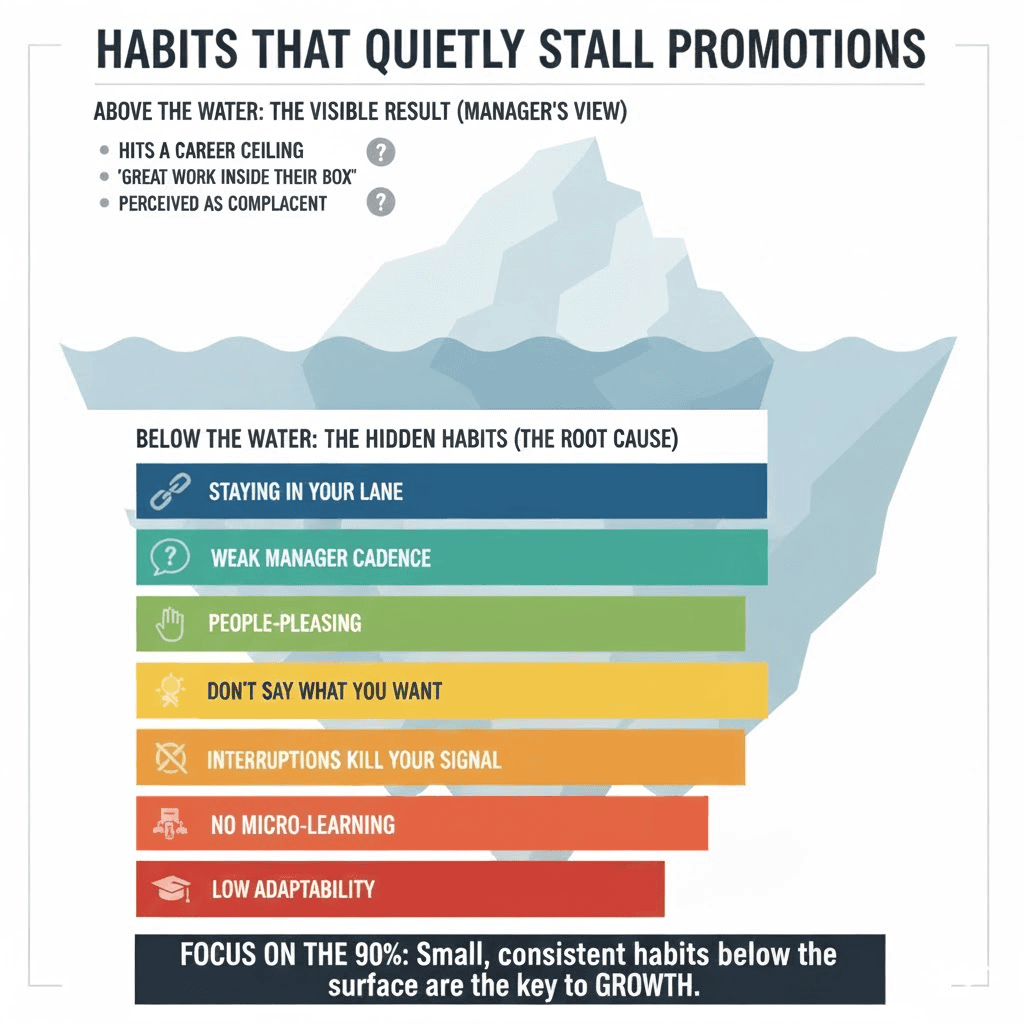
Don’t Say What You Want
If your manager doesn’t know you want the next level, they won’t risk promoting someone who comes off as complacent. Clear ambition isn’t arrogance; it’s context.
Make the fix: State your real intent in a 1:1 (“I’m targeting [Level/Title] this cycle. Can we align on the scope and milestones you’d need to see?”). Then send a monthly, 5-line progress recap directly tied to that scope.
Weak Manager Cadence
Skipping 1:1s or treating them like status meetings hangs your promotion on your manager’s perception and the notes of others. You need a steady rhythm where you show you can bring critical thinking, not just status updates.
Make the fix: Come with the simple frame: Problem → Options → Recommendation. Close with, “Anything that would change your recommendation?” Record their guidance in your impact log.
People-Pleasing or Soft Agreements
Always saying “yes” comes off as “agreeable operator,” not future lead. Leaders trade time for leverage and push back, with good reasons.
Make the fix: Practice one principled “no” per week: “To hit [X] by Friday, I’d need to drop [Y] or move [Z], what takes priority?” Prioritizing is not refusing, it shows future leadership skills.
Staying in Your Lane
Great work inside your own box looks… like you fit in that box. Promotions require evidence that you actively improve systems, not just finish tasks.
Make the fix: Pick one cross-team friction-point (handoff, reporting, scheduling, etc.). Test out one tiny fix, measure it, and if it works, share the before/after. One cross-team visible system win definitely beats ten quiet, individual wins.
Low Adaptability to New Tools/Processes
If others have to drag you into new workflows (AI automation, a new CRM, updated safety guidelines, budgeting), you’re going to come off as maintenance, not next in line for a promotion.
Make the fix: Volunteer to teach a new process or how to improve a current one. Then write up a new “quick-start guide” as a new piece of training material, authored by you. Again, those visible system wins are some of the best you can accomplish.
No Micro-Learning/Mentoring
If it seems like nobody gets better around you, you may be a strong solo contributor. But promotions go to those who can help lift others up, too… not just lift-and-carry.
Make the fix: Find and “adopt” one new hire. Share your checklists, review one of their tasks per week, and track their expedited onboarding time. Put the improvement in your impact log.
Interruptions Kill Your Signal
Spending your time on constant, minor requests and immediate demands leads to producing fragments you can’t put in your impact log. Deep work is what produces meaningful outcomes; those constant interruptions lead back to busywork, not promotable achievements.
Make the fix: Block a recurring no-meeting window. Check and reply to messages twice a day. For common or routine tasks, write up a one-page “How to get [X] from me” and point people there.
You Don’t Ask for Criteria, or Timing
Guessing what “done” means leads to miscommunications or even misfires and last-minute scrambles.
Make the fix: Ask for the specifics and the expected timeframe. “What scope and metrics define [Level of project]? What is the timeline for submitting?” Then stack up some visible wins in that 6-8 week window.
Bottom line: Say your goals out loud, run a tight 1:1, trade low priority tasks for visible system wins, teach while you learn, protect your deep-thinking time, and always stick to the true specifics and timeline for submitting. Small habits, repeated, can positively change how you’re seen or even promoted.
Build a Visibility System
Good work is obviously necessary; but it’s seen work that gets you promoted. Don’t spam your leadership with updates, stick to a system that makes recent impact obvious without looking too performative.
Impact Logs are Golden Tickets
Keep a running document you update as you go. Five columns are enough: Date · Outcome · Metric · Stakeholder · Proof. You want to write quick, digestible receipts… not 2-page essays. Save it in an obviously-labeled folder (e.g., Impact Log FY25 > Artifacts) so your manager can drop in and see your progress or use it for your next performance review.
Example entry:
2025-09-12 · Cut ticket backlog 38% in 3 weeks · 426 → 264 open tickets · Ops Dir signed off · Dashboard link + before/after screenshot
Weekly “3 Bullets”
Once a week, send a short email/DM that takes ~60 seconds to read.
- Win: One measurable outcome (“Vendor switch saves $18k/yr; finance confirmed”).
- Learning: One takeaway (“QA fails occurred on handoff, we added a 2-step checklist”).
- Next: One actionable move (“Lead checklist on Team B; report by Friday”).
Paste a link to your impact log at the bottom. That’s it. Weekly consistency wins.
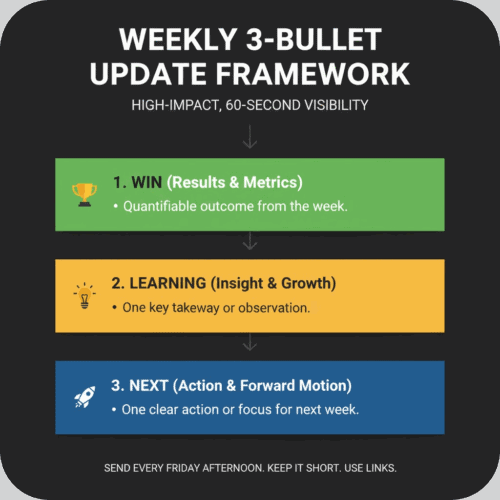
Monthly Report to Stakeholders
For readability, keep your report a one-page resource that’s only links. All information should be hyperlinks that are on a single, clean page, with no extra text.
- Audience: The few people who have a direct effect from your work.
- Sections: Outcomes, Risks/Blocks, Requests. Use links, screenshots, and one chart max.
The goal for this monthly check-in is simply alignment and providing receipts.
Make Clear Content
Leadership runs on forwarded emails and DMs. Present your accomplishments in an easy-to-read before/after chart, a quick 60-second explainer video, or a one-paragraph summary with a number and a quote. Save them in an obviously-labeled folder (e.g., Impact Portfolio FY25 > Artifacts) so your managers and leadership can easily see your consistent/growing progress.
Quick Start Kit
- Create the Impact Log file with the five columns: Date. Outcome. Metric. Stakeholder. Proof. Add two entries this week.
- Block your calendar for a 15-minute Friday wrap-up to send your 3 bullets.
- Schedule a 10-minute end-of-month review meeting with your main stakeholders; trim your pitch down to one page.
The process is short and to the point on purpose. You shouldn’t have to market yourself when it’s already easy for decision-makers to see your timely, and verifiable, impact.
Advocates and Career Goals
Results show your can-do; advocates are the ones deciding who. Promotions, after all, are just social decisions made by people comparing notes. Make it easy for the right people to vouch for your consistency, with receipts.
Manager ≠ Mentor ≠ Sponsor
Your manager is responsible for clearly defining a project’s boundaries and writes-up the requirements. A mentor is a separate trusted source for informal, personalized, off-the-record advice on your career development and guidance. Your sponsor is in the room during manager meetings and says, “I’ve seen their impact, we should promote them.” Sometimes though, you’ll need approval from all three; start by getting your manager to “yes,” then add a sponsor who can benefit from your work.
Recruit a Sponsor
A sponsor is the voice in the calibration meeting who will back-up your impact. Make your pick quickly, a sponsor has more to vouch for the more they see/know you can do. Don’t go and ask for a favor first; earn sponsorship by showing your real value.
Earn Your Advocacy
Advocacy comes after value is established. Before you start asking for support, try and do something for your target sponsor first. Find small and useful solutions to their team’s pain points and offer a 15-minute show-and-tell. Focus on something that makes their world easier: remove an unnecessary block, finish that lingering cross-team task, or listen for a common nagging problem then fix it.
Follow-up with a 3- to 5-line recap of: the task, the key performance indicator and the before/after. Before you know it, you’ll be making the right people say “I’ve been seeing their good work.”
Keep Goals Short and Focused
Leaders prefer succinct recaps. Hand them a summary they can speed read and pass along.
Packet line example: “Reduced onboarding from 12→7 days across two regions (18 managers signed off). Led rollout plan and risk log; savings: ~240 staff hours/quarter.”
Scripts You Can Use
- Stating Intent (to you manager): “This cycle, I am targeting a promotion to [level/title]. My plan involves [scope] and driving [metrics]. What is most important for us to align on for this to happen?”
- Sponsor Opener: “I resolved [their team’s pain] by taking [action], it had a [metric] impact. I can give you a 10-minute walkthrough and send over the presentation deck if that would be helpful.”
- Soft Nudge (6–8 weeks out): “For your convenience, here is a one-page summary of the outcomes, relevant quotes, and links. The content can be directly incorporated into your [documentation/performance review/etc.].”
Avoid Common Mistakes
- Vague Praise Requests: Don’t ask “Can you put in a good word?” It’s much better to give someone a specific line and link.
- Asking Before Delivering: Earn your first few “yeses” with a solved problem or system fix.
- Single-Threading: If advocacy rests on one person, you’re more fragile. Aim for advocacy from your manager + a sponsor + one stakeholder.
- Quiet Months: Calibration meetings remember recent accomplishments. Keep at least a couple small wins visible every week. Aim for the cross-team visual wins for greatest impact.
Advocacy is much easier to secure when you’ve already done the thinking for them: clear impact, clean phrasing, and links they can simply copy and paste.
Remote/Hybrid Adjustments
Since you won’t have as many, if any, casual office run-ins, you need to proactively create visibility. For virtual updates, use short 60-90 second explainer videos for demos and add screenshots to your impact log file. Schedule a 15-minute meeting to check in without a packed agenda. When you are in the office, deliberately plan your visible interactions like a cross-team demonstration, have a coffee with your sponsor, and check in with one of your main stakeholders.
Set Aside Time
Being always available shows you’re a “great operator.” Protecting time to think, decide, and design comes off as future leader.
Make a Deep-Work Block
Put a recurring 90-120 minute block on your calendar 1-2×/week. Name it after the intended output, not “focus” (e.g., “Q4 Churn Analysis,” “Incident Playbook v2”).
Defend it Politely: Have an auto-reply set for that window, “Heads-down on [specific work] until [time]; I’ll circle back after.”
Shrink Meetings; Grow Outcomes
Most meetings are just status updates. Status belongs in a document.
- Move these updates to a one-page doc or 90-second video, sent the day before.
- When you really do have to meet: 50-minute max by default, agenda up front, decision owner clearly named, end the meeting with the owner + deadline + any next steps.
- Batch your 1:1s. Use a 30-minute block (broken into three 10-minute mini-meetings) to reduce context switching throughout the day.
Tame Your Dopamine Loop
Your attention is your work-budget. Treat it like one with an input diet.
- Inbox Checks: Limit yourself to 2-3 set times/day, not checking a constant stream.
- Notifications: Keep them off by default; send through only high priority chat channels and only certain people.
- Channels/Newsletters: Just unsubscribe or get to them all in a single weekly read-a-thon. If it doesn’t move a KPI, it probably shouldn’t be a daily input.
Delegate and Template
If you’ve created the same something three times, it’s time to template it.
- Create Standard Operating Procedures + snippets for FAQs (“How to request X,” “Where to find Y”).
- Point routine requests to the shared doc or form; review daily.
- Teach one person your get though it checklist; let them run it, then you review the outcome.
Decision Hygiene
The Core Principle: Promotable people reduce uncertainty. Your goal is to make decisions simple and traceable.
- Standardize Decisions: Use the same frame every time: Problem → Options → Recommendation → Risks → Owner/Date.
- Track Judgment: Keep a lightweight decision log (date, decision, who, link). It saves re-hashing and shows judgment over time.
- Use Data: Escalate any issues early with proof: charts, analyses, clear options. Always stick to facts, anecdotal information can come back to bite you.
- Prepare for Reviews: Save all of your logs/artifacts/projects notes in your impact log file to easily recall for reviews.
Make Artifacts That Travel Without You
Meaning, a manager or stakeholder should be able to simply forward your work and have it still land.
- Pre-read: one page, one chart, one specific and clear action or decision you need the reader to take after reviewing the material.
- Post-read: 5 bullets: Outcome, Metric, Risk, Owner, Timeline.
Scripts & Snippets (Steal These!)
Calendar Description (Defense, Polite):
“Working session to produce: [Deliverable]. If urgent, call; otherwise I’ll reply after [time]. Pre-reads welcome.”
Auto-Reply (During Block):
“Thanks, heads-down on [deliverable] until [time]. If urgent, please call me; otherwise I’ll respond after.”
Team Message:
“To unblock faster, let’s try: updates in a one-pager by EOD Thu; 20-min decisions Fri AM; urgent = phone. I’ll hold Tue/Thu 9-11a for design work so we deliver cleaner.”
This Week’s Big Signal
- Add two named deep-work blocks and make sure you protect them once.
- Convert one standing status meeting into a pre-read + 20-min decision.
- Turn one recurring task into a template/SOP and hand it off.
- Send one pre-read and one post-read on a real decision.
Protected thinking time lifts Results (better work), Trust (clear judgment), and even Visibility (visible accomplishments). Do this consistently for three weeks and leaders start seeing and treating you like the kind of person they promote. With three of the four parts of our equation covered, the only thing left will be finding the perfect Timing.
Recognition Gaps Are Real
Feeling overlooked is common and it’s usually structural, not personal. Attention is scarce, recency bias is real, remote work can hide equal effort, and “glue work” (coordination, prevention, onboarding) very rarely has a measurable metric. Instead of dwelling, make sure your valuable, behind-the-scenes work is translated into measurable outcomes and is available when and where decisions are being made.
Spot What Isn’t Visible
Some wins can’t announce themselves, like: avoided incidents, sped-up handoffs, onboarding that just “clicked.” List these and convert each into a before/after, a number, and a stakeholder who can confirm it.
- Example: “Kept Q3 release on schedule by aligning 4 teams; avoided a 2-week slip (~$45k in burn) by catching issue early. Ops + Eng leads signed off.”
Make Proof That Lasts
Tangible artifacts beat he-said-she-said anecdotes. Create at least one thing per week someone can benefit from or forward on:
- A single chart (before/after), a 60-second explainer video, or a one-paragraph summary with a link and a quote.
- Save them in [Impact Log FY25 > Artifacts] so your manager can drop them straight into your performance review.
Calibrate with Leadership
Promotable people don’t wait for feedback; they actively seek the steps for the next level. Stop relying on “vibes” and get down to actual specifics so you can structure your work to line up with your manager’s goals and the company’s definition of success.
- Define Success: Ask your manager to provide concrete, undeniable examples: “What examples would make this a clear ‘Yes’ for the [Next Level Title] role?” This forces them to move beyond abstract job descriptions.
- Understand Your Audience: Know who evaluates your work and what motivates them. Ask: “Who will be in the room when my performance is reviewed, and what specific outcomes do they care about most?”
- Time Your Documentation: Sync your visible achievements with the review process. Ask: “When do review packets start getting written? I’ll stack my most recent, high-impact outcomes into that window.”
- Mirror the Language: Once you get their specific examples and success metrics, mirror the language exactly in your decision logs and review artifacts. This makes it nearly impossible for the reviewers to miss your work.
Proactive Recognition for Remote Work
If you are remote, you’ll need to conjure up your own “hallway moments” to make sure your contributions and influence don’t fade away.
- Weekly Wins Check-In: Every Friday, send a single, short email (3-5 bullets max) to your direct manager listing your most impactful and quantifiable outcomes for the week.
- Monthly Micro-Demo: Present a brief, high-impact 10-minute demo using just one slide to highlight a positive outcome.
- End-of-Month Report: Send a succinct summary to any of the affected teams: list outcomes, risks, and requests (using links only, not long paragraphs).
- Maximize In-Office Days: Stack high-value interactions together: schedule a sponsor coffee, one cross-team demo, and a key stakeholder sync on the same day.
Keep it Fair and Sane
If patterns do point to bias (e.g., credit being stolen, criteria constantly shifting), make sure you document your artifacts, the dates, and who was in the room. Raise the issue with your manager or HR to fix the issue.
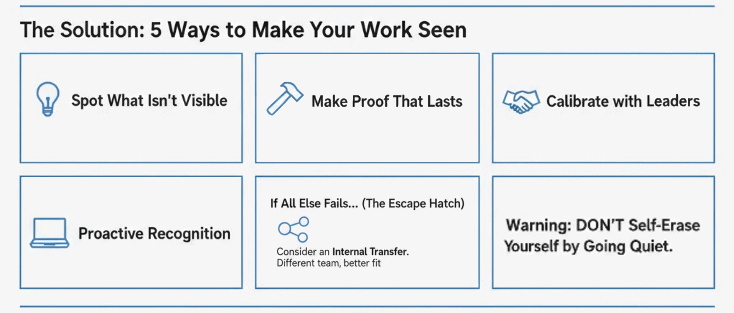
If that seems implausible you can consider an internal transfer where your work might line up better under a different leader’s goals. Just don’t self-erase yourself by going quiet.
30-Day Sprint Plan
Getting recognition isn’t just luck (well, not most of the time anyways). It boils down to actual receipts and consistent good work on a set schedule.
The Goal: Send proof in every step of the process (Results, Visibility, Trust, Timing) for one month, then keep rolling it forward.
Week 1: Setup & Baselines
You’re laying track, not sprinting (yet). Say your goal out loud, start capturing receipts, protect real thinking time, pick one cross-team problem you can fix fast, and send a simple weekly update. By Friday, you’ll have something measurable, visible, and repeatable.
Deliverables: Make sure your impact log started; deep-work blocks on calendar; problem chosen + baseline metrics recorded; then boom, first 3-bullet sent.
- Say your goal out loud: In your 1:1, “I’m targeting [level/title] this cycle, can we discuss the steps to take and what a clear yes looks like?” Record their exact wording.
- Create your Impact Log: Date · Outcome · Metric · Stakeholder · Proof (link/screenshot/quote). Add two real entries this week.
- Protect Thinking Time: Add two specifically named 90-120 min blocks (e.g., “ATS Integration SOP v1 or Onboarding Playbook v3_West rollout”). Turn on an auto-reply during these blocks to stay focused.
- Pick One Cross-Team Issue and commit to resolving it within two weeks. First, measure the current performance, then test out your fix, measure the resulting improvement, and if it worked, share the before/after.
- Launch Your 3-Bullet Update: Send your first weekly update using 3 bullets (Win, Learning, Next).
Results: When you follow these steps, you’ll immediately show to your managers that you are organized, focused, and measurable.
Week 2: One Visible Win
This week focuses on completing your first system improvement and capturing the evidence so it’s easy for others to understand and share.
Deliverables: Solution implemented + metric recorded; proof saved; stakeholder summary sent.
- Complete Something Small: Implement your solution (the checklist, new intake form, etc.) and measure the before-and-after impact against the baseline you set last week.
- Create Forwardable Proof: Generate one key piece of evidence (e.g., 1 chart or 60-second video explainer + link). Save this proof to your impact log file so your manager can easily see and share it.
- Share a Stakeholder Summary: Send a concise one-page summary (using links only) to any stakeholders affected. Detailing outcomes ⋅ Risks/Blocks ⋅ What you need from them.
- Keep 1:1s Decision-Focused: Start meetings with the template: Problem → Options → Recommendation. Then ask, “Anything that would change your recommendation?” and log any feedback.
Results: You check the Results + Visibility boxes in the same week.
Week 3: Extend & Advocate
This week is about proving your work can scale and proactively recruiting advocacy to build Trust.
Deliverables: Second win scaled; sponsor value drop completed; pre-/post-read pair documented; stakeholder quote captured.
- Scale Your Win: Roll out your successful fix to a second team or region and note the new improvement (e.g., 12→7 days across [regions or teams]).
- Earn a Sponsor: Solve a small pain point for your chosen sponsor. Follow up immediately with a 4-5 line recap including the metric and link.
- Convert a Status Meeting: Shift one status meeting into a pre-read +20-min decision. Note the project owner, date, and next step in a quick post-read.
- Collect Proof: Get a quantifiable endorsement from a manager or customer. Collect a quote (e.g., “This removed [pain]; we saved [X].”) and add it to your core artifact.
Results: Trust rises because others can now vouch for your consistency and impact.
Week 4: Package & Propose
This final week is dedicated to packaging all your evidence into a forwardable case and formally setting the promotion in motion, fully engaging the Timing lever.
Deliverables: One-pager drafted; formal proposal made; comp/level guardrails captured; final month-end digest sent.
- Draft Your One-Pager: Create your proposal including: 3-4 quantifiable outcomes with links and quotes; scope you already carry; 6-month plan that “pays for itself”; your sponsor’s name and any quotes; and a backfill plan.
- Make the Formal Proposal: In the T-30 to T-14 window, share the One-Pager with your manager. Confirm the review timing and who will be in that room.
- Set Guardrails: If scope increases, align on the compensation path (band or a dated checkpoint) and get this agreement in writing or email.
- Final Digest: Send a concise one-page summary to stakeholders with the month’s outcomes, and cc your manager.
Results: The Timing box is now fully engaged with an easy-to-forward case in hand.
Metrics to Watch
Your promotion case will be strong if you tick-off these non-negotiable goals within your 30-day sprint:
- 2-3 quantified outcomes.
- At least 3 artifacts saved.
- One win delivered to a sponsor.
- Zero “quiet weeks” in the decision window.
Ask the Long Way: The 60-Day Plan
Promotions aren’t a surprise party. Treat the entire conversation like a mini business case: show evidence of impact, highlight the scope you’re already carrying, and present a plan that pays for itself. Start early enough so your manager has time to move the pieces.
- T-60 Set the Target:
- State Intent in a 1:1 with your manager.
- Align on specifics and what a “clear yes” looks like.
- Goal: Alignment
- T-45 Get Feedback:
- Share a draft of your One-Pager (outcomes, artifacts, sponsor quote).
- Ask your manager, “What’s missing?”
- Goal: Feedback & Polish
- T-30 De-Risk Your Case:
- Confirm the new scope you’ve already taken on.
- Add one cross-team deliverable that will land before the final submission.
- Goal: De-Risking
- T-14 Package & Submit:
- Send the final One-Pager and links.
- Confirm who’s in the room and packet deadlines.
- Goal: Final Review
- T-7 Build Final Momentum:
- Send a light reminder with any fresh, recent wins (new metrics, positive quotes).
- Goal: Momentum
- Send a light reminder with any fresh, recent wins (new metrics, positive quotes).
- T+1 Convert Any Negatives:
- If it’s a No or Not Yet, that’s okay.
- Schedule a debrief immediately and convert that into your next-cycle plan.
- Goal: Contract
Your One-Pager
This single document should be easy to forward and impossible to dispute.
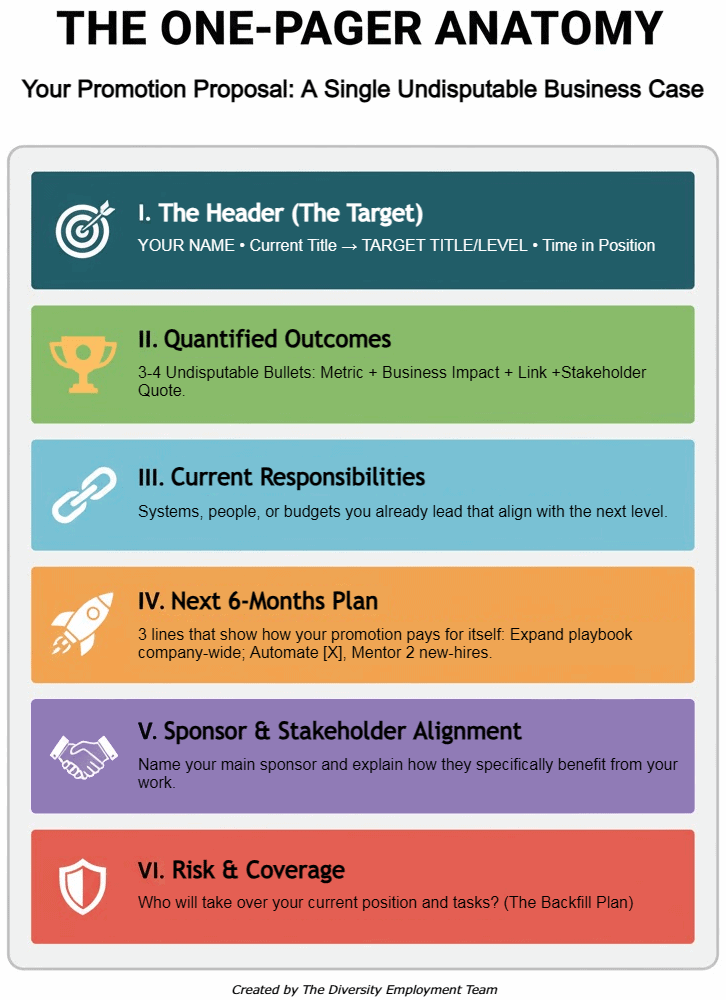
Header:
Name · Current Title → Target Title/Level · Time in Role
Outcomes (3-4 bullets):
Metric + Business Impact + Link + Stakeholder Quote. (Replace adjectives with data.)
Scope Already Carried:
Systems, people, or budgets you lead now that align with the next level.
Next 6-Months Plan:
3 lines that pay for the promotion (e.g., expand playbook org-wide; automate X; mentor 2 new leads).
Sponsor/Stakeholder:
Name + how they specifically benefit from your work.
Risk/Coverage:
Who backfills your current tasks (to show your manager you’ve thought ahead).
The Promotion Conversation
Your goal is not to have an emotional debate; your goal is to present a pre-approved business case. Make the final request “boring” in the best way: short, data-backed, and easy for your manager to forward up. Let your documented work speak for itself.
If They Say “Not Now”
If the decision is a no or deferred, immediately transform that rejection into a binding contract for the next cycle.
Script for Debrief Request: “Understood. For the next cycle, can we write down the three specific examples that would make this a ‘Yes,’ plus the timeline? I’ll implement them into my plan and provide examples as I go.”
Lock it in writing (email recap). Add dates and owners. Treat it like a project. Save it to your Impact Log.
Avoid the “Dry Promotion”
A new title without wider scope or pay nearly always creates future problems. Bring options to the table, not ultimatums.
Script for Avoiding a Dry Win: “I’m excited about the bigger scope. To keep this sustainable, can we talk about a compensation movement within [band/range] or set a dated checkpoint tied to [deliverable/metric] for a compensation review?”
Negotiation Specifics
- Lead with your business impact, not comparisons to peers work.
- If you reference market data, keep it light: “Given [internal band/peer roles], I’m targeting [X–Y]. Happy to work within our structure.”
- Trade tasks for scope to ensure focus.
Red Flags to Avoid
Some things can immediately shift the conversation from a business case to an emotional plea, which very rarely succeeds.
- Vague Requests: Never anchor your argument on subjective feelings like, “I deserve it,” or “It’s my turn.” If you can’t back the promotion with receipts and data, you aren’t ready to ask for it.
- Threats or Market Ultimatums: Framing the conversation as “Give me this title or I’ll leave for an external offer” forces your manager into a defensive, reactive posture and can wipe-out long-term trust. Lead with your value, not your leverage (even if you do have it).
- Promising More Hours: Your job at the next level is to achieve more leverage and greater impact, not just work longer and harder. Focus the conversation on how you will scale your outputs, mentor others, or automate processes, don’t just go on promising more hours.
- Accepting Undefined Scope: Never agree to take on large, new responsibilities without an official title or compensation change and a documented checkpoint. If the new position lacks visibility or a clear evaluation date/criteria, you risk getting forced and stuck in a higher-level role at lower-level pay.
Don’t Self-Stall Your Promotion
Promotions stall when small, repeated mistakes keep derailing your great work. Focus on correcting the underlying habits and communication patterns causing the mistakes to unstick your career progression.
1) Overwork Without Leverage
Problem: You take on more hours, but not a better title.
Fix: Trade tasks for systems. Document → delegate → inspect.
Instead of: “I’ll just take it on.”
Try: “I can lead the rollout if we reassign weekly QA checks to [Name] by Friday; if so, I’ll publish the checklist and spot-audit weekly.”
2) Vague Claims, No Receipts
Problem: You try to show “Impact” using adjectives and effort, not evidence. This forces decision-makers to guess your real value.
Fix: Every win needs a receipt. Tie your achievements with three non-negotiable pieces of evidence: One metric + one link + one confirmer.
Instead of: “Improved onboarding a lot making the process faster and easier.”
Try: “Reduced onboarding time 12→7 days across two regions; ~240 staff hours/quarter saved. [Dashboard], ‘Huge lift’ (Ops Director quote).”
3) Waiting for Permission
Problem: You ship activity, not initiative. Waiting for a “Go-Ahead” signal delays impact and limits your perceived scope.
Fix: Lead something small first, then show the before-and-after. Instead of asking permission to try an idea, show your manager the results you’ve already generated.
Instead of: “Should we try a checklist?”
Try: “I tested a 2-step checklist on Team B: defects dropped 31% in two weeks. Proposal attached to expand.”
4) Quiet Months Near Calibration Meetings
Problem: Decision-makers have recency bias. When performance is reviewed, they really only remember your most recent outputs, making silence near the deadline a metaphoric “shot in the foot.”
Fix: Don’t go quiet. Strategically present your most visible wins 6-8 weeks out and consistently run your 3-bullet updates to keep your impact upfront.
Instead of: (Silence and waiting for the review)
Try: “Win: Vendor switch saves ∼$18k per year (Finance confirmed). Learning: Most delays happen at the handoff stage. Next: Lead new intake form on Ops West, report Friday.”
5) Single-Source Advocacy
Problem: Your visibility is only to one person. If only your manager knows your work, your promotion case can be fragile and lack critical validation from the decision-making table.
Fix: Widen your support network. Add at least one sponsor and one stakeholder quote to every major artifact to prove your impact is felt across the organization.
Instead of: “My manager knows what I’ve accomplished.”
Try: “Sponsor: CX Director (adopted our playbook across the entire organization). Stakeholder Quote: ‘Cut tickets by 38% in 3 weeks’ – Head of Ops.”
6) Scope Expands Without Compensation
Problem: Accepting a bigger job at the same level and pay is the “dry promotion.” You are penalized for being competent by taking on senior scope without equal reward.
Fix: Every new, major addition must be correlated to a documented time and a compensation range. Your agreement to take on the work is conditional on clear, time-bound movement.
Instead of: “Happy to take it on.” (Undocumented)
Try: “I’ll gladly lead the program and hand off my current tasks to [Name] by [date]. Can we set a mid-cycle compensation review, that fits the [next level band], if we hit [specific metric]?”
7) Credit Diffusion (Work Vanishes in Your Groups)
Problem: Your contributions are lost to a “team win.” When the group succeeds, your specific impact remains unclear, making it impossible for managers to find a case for your promotion.
Fix: Even (especially) in group projects, note your specific job and deliverables clearly within all pieces and updates. Move from saying what the team did to saying what you enabled.
Instead of: “The team shipped X.”
Try: “I led the risk log and rollout plan; unblocked the core data feed; which enabled the team to ship X on time. Quote and link to the final metric attached.”
8) Tool/AI avoidance
Problem: Resisting or ignoring new technology (tools, AI, automation) makes your work more “maintenance” instead of growth and innovation. This immediately flags you as a risk for future scalability.
Fix: Don’t just use the new tools… learn, document, and teach them to someone else. By sharing the playbook, you show your leadership and operational improvement.
Instead of: “I prefer the old way.”
Try: “I lead the new tool implementation, wrote a 1-page quick start guide, and ran a 20-min huddle with the team; cycle time dropped 22%.”
9) Sprawling Meetings
Problem: Your meetings are hours of talk with nothing presentable to forward. If a decision is made, it dies in the room because no one documents a clear outcome or next step.
Fix: Pre-read → 20-min decision → post-read. The goal is to maximize the speed of decision-making and generate a clear, forwardable record of accountability.
Instead of: “Let’s schedule another sync.”
Try: “Pre-read attached; decision owner: [Name]; 20-minute slot confirmed. The Post-read will capture the owner, date, and next step for immediate distribution.”
Run the System, Not a Treadmill
Now we know the formula Results × Visibility × Trust × Timing = Promotion. Your job is to check each box, week after week, with receipts that can be understood without you having to explain. Track your outcomes, send them regularly, protect your deep-work time, line up a sponsor, and make a calm, business-first promotion request.
Keep it boring in the best way: numbers, links, quotes, dates. Stay away from dry promotions, write down expected criteria and checkpoints, and recycle the 30-day sprint above until the answer is “yes.”




